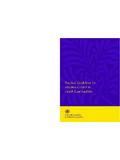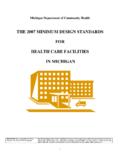Transcription of Hand Hygiene in Outpatient and Home-based Care and Long ...
1 Hand Hygiene in Outpatient and Home-based care and Long-term care facilities A Guide to the Application of the WHO Multimodal Hand Hygiene Improvement Strategy and the My Five Moments for Hand Hygiene Approach Hand Hygiene in Outpatient and Home-based care and Long-term care facilities A Guide to the Application of the WHO Multimodal Hand Hygiene Improvement Strategy and the My Five Moments for Hand Hygiene . pproach WHO Library Cataloguing-in-Publication Data: Hand Hygiene in Outpatient and Home-based care and long-term care facilities : a guide to the application of the WHO multimodal hand Hygiene improvement strategy and the My Five Moments For Hand Hygiene approach. standards. care standards. infection prevention and control. care services standards. care . Health Organization. ISBN 978 92 4 150337 2 (NLM classification: WB 300). World Health Organization 2012. All rights reserved. Publications of the World Health Organization are available on the WHO web site ( ) or can be purchased from WHO Press, World Health Organization, 20 Avenue Appia, 1211 Geneva 27, Switzerland (tel.)
2 : +41 22 791 3264; fax: +41 22 791 4857; e-mail: Requests for permission to reproduce or translate WHO publications whether for sale or for noncommercial distribution should be addressed to WHO Press through the WHO web site ( ). The designations employed and the presentation of the material in this publication do not imply the expression of any opinion whatsoever on the part of the World Health Organization concerning the legal status of any country, territory, city or area or of its authorities, or concerning the delimitation of its frontiers or boundaries. Dotted lines on maps represent approximate border lines for which there may not yet be full agreement. The mention of specific companies or of certain manufacturers' products does not imply that they are endorsed or recommended by the World Health Organization in preference to others of a similar nature that are not mentioned. Errors and omissions excepted, the names of proprietary products are distinguished by initial capital letters.
3 All reasonable precautions have been taken by the World Health Organization to verify the information contained in this publication. However, the published material is being distributed without warranty of any kind, either expressed or implied. The responsibility for the interpretation and use of the material lies with the reader. In no event shall the World Health Organization be liable for damages arising from its use. Design by Common Sense, Greece Printed by the WHO Document Production Services, Geneva, Switzerland 2. Contents Acknowledgements .. 5. Abbreviations .. 6. Introduction and essential notes for the reader .. 7. 1. Objectives .. 8. 2. Definition and scope .. 8. 3. Target audience .. 9. 4. Why is hand Hygiene important in Outpatient care ? .. 10. 5. Application of the My five moments for Hand Hygiene approach in Outpatient care .. 13. The patient zone and health- care area concepts in Outpatient settings .. 13. The My five moments for hand Hygiene approach in Outpatient care .
4 14. 6. Application of the WHO Multimodal Hand Hygiene Improvement Strategy and accompanying toolkit in Outpatient care .. 18. System change .. 18. Training and education .. 19. Evaluation and feedback .. 19. Reminders in the workplace .. 20. Institutional safety climate .. 26. 3. HAND Hygiene IN Outpatient AND Home-based care AND LONG-TERM care facilities . 7. Practical examples of hand Hygiene requirements in a broad range of Outpatient care settings .. 27. Introduction and essential notes for the reader .. 27. Practical examples .. 28. 1. Public vaccination campaign .. 28. 2. Blood drawing in a laboratory .. 30. 3. Visit to a general practitioner's office .. 32. 4. Paediatric consultation in a health post .. 34. 5. Consultation in an emergency polyclinic .. 36. 6a. Home care helping a disabled patient to bathe .. 38. 6b. Home care wound dressing .. 40. 7. Chest X-ray in a diagnostic centre .. 42. 8a. Haemodialysis in a specialized ambulatory clinic start of dialysis.
5 44. 8b. Haemodialysis in a specialized ambulatory clinic during the dialysis session .. 46. 8c. Haemodialysis in a specialized ambulatory clinic disconnection at the end of dialysis .. 47. 8d. Haemodialysis in a specialized ambulatory clinic after patient departure .. 49. 9. Childbirth and delivery assistance .. 50. 9a. Childbirth and delivery assistance during labour .. 50. 9b. Childbirth and delivery assistance at time of delivery .. 51. 9c. Childbirth and delivery assistance after the departure of mother and child from the delivery area .. 53. 10. Dental care in a clinic .. 54. 11. Check of vital and clinical parameters in a bedridden resident of a nursing home .. 56. 12. Changing the diaper of a bedridden resident in a LTCF .. 58. 13. Physiotherapy and mobility exercise care to an elderly person in a nursing home .. 60. References .. 62. Appendix I.. 65. Appendix II.. 66. 4. ACKNOWLEDGEMENTS Didier Pittet This publication is the product of contributions by several WHO Collaborating Centre on Patient Safety individuals.
6 The publication was written by Benedetta University of Geneva Hospitals and Faculty of Medicine, Geneva, Switzerland Allegranzi and Sepideh Bagheri Nejad, WHO Patient Safety Programme, Geneva, Switzerland, Christiane Reichardt Institute of Hygiene and Environmental Medicine, and by Marie-No lle Chraiti, WHO Collaborating Centre University Medicine Berlin, Charit , Germany on Patient Safety, University of Geneva Hospitals, Lisa Ritchie Geneva, Switzerland. The publication was developed Health Protection Scotland, Glasgow, United Kingdom thanks to the essential technical input and support Philip L Russo by the Ministry of Health, Social Services and Equality Austin Health, Heidelberg, Victoria, Australia of Spain. Critical technical input was also provided by the WHO Collaborating Centre on Patient Safety, Hugo Sax Division of Infectious Diseases and Hospital University of Geneva Hospitals and Faculty of Medicine, Epidemiology, University Hospital of Zurich, Switzerland Geneva, Switzerland.
7 Luisa Torijano-Casaluenga Writers Spanish Society of Community and Family Medicine, Benedetta Allegranzi Talavera de la Reina, Toledo, Spain WHO Patient Safety Programme, Geneva, Switzerland Reviewers Sepideh Bagheri Nejad ~. Pilar Astier-Pe na WHO Patient Safety Programme, Geneva, Switzerland Spanish Society of Community and Family Medicine, Marie-No lle Chraiti Zaragoza, Spain WHO Collaborating Centre on Patient Safety, Barry Cookson University of Geneva Hospitals and Faculty of Medicine, Health Protection Agency, London, United Kingdom Geneva, Switzerland Nizam Damani Contributors Craigavon Area Hospital, Portadown, Craigavon, United Kingdom Yolanda Agra-Varela Directorate General of Public Health, Quality Francisco Javier Hern andez-Herrero and Innovation, Ministry of Health, Social Services La Gomera Primary Healthcare, Canary Islands Health and Equality, Madrid, Spain Service, San Sebastian de La Gomera, Canary Islands, Spain Mar a del Mar Fern andez-Ma llo Directorate General of Public Health, Quality Claire Kilpatrick and Innovation, Ministry of Health, Social Services Health Protection Scotland, Glasgow, United Kingdom and Equality, Madrid.
8 Spain Edward Kelley Soledad Alonso-Humada WHO Patient Safety Programme, Geneva, Switzerland Almer a Primary Healthcare District, Andaluc a Region Elaine Larson Health Service, Almeria, Spain Columbia University School of Nursing, New York, USA. M. Carmen G mez-Gonz alez Maribel Maci an-Morro Spanish Society of Primary Health care Practitioners Nursing Federation of Community and Primary Health (SEMERGEN), Badajoz, Spain care , Caravaca de la Cruz, Murcia, Spain B atrice Jans Shaheen Mehtar Scientific Institute of Public Health, Brussels, Belgium Tygerberg Hospital and Stellenbosch University, Tygerberg, Cape Town, South Africa Ana Mart nez-Rubio Spanish Association of Primary Healthcare Pediatrics, Andreas Voss Canisius-Wilhelmina Hospitals and Radboud University Sevilla, Spain Nijmegen Medical Centre, Nijmegen, The Netherlands Jes us Molina-Cabrillana Spanish Society of Preventive Medicine, Public Health Editor and Hygiene , Las Palmas de Gran Canaria, Spain Rosemary Sudan, Freelance editor Maria Luisa Moro Agenzia Sanitaria e Sociale Regionale Regione Design and figures Emilia-Romagna, Bologna, Italy Common Sense, Athens, Greece Fernando P rez-Escanilla Spanish Society of General Practitioners and Family The Ministry of Health, Social Services and Equality Doctors, Spain of Spain kindly funded and hosted an experts'.
9 ~. Teresa Pi-Sunyer-Canellas consultation in Madrid on 17 November 2011 to discuss External Consultant, Barcelona, Spain the content of this publication. 5. HAND Hygiene IN Outpatient AND Home-based care AND LONG-TERM care facilities . ABBREVIATIONS. ABHRs alcohol-based handrubs ESBL extended-spectrum beta-lactamases HBV hepatitis B virus HCAI health care -associated infection HCV hepatitis C virus HCW health- care worker LCTF long-term care facility MRSA methicillin-resistant Staphylococcus aureus USA United States of America UTI urinary tract infection VRE vancomycin-resistant enterococci WHO World Health Organization 6. INTRODUCTION AND ESSENTIAL NOTES account the available resources and most frequent FOR THE READER procedures undertaken locally. Additional practical tools for evaluation, education, and learning targeted The World Health Organization (WHO) recommendations at health- care providers in Outpatient care settings are on hand Hygiene best practices and improvement strategies currently under development by WHO and should be used are considered the gold standard for health- care worldwide.
10 In association with this guidance document. Over the last six years they have been implemented in thousands of facilities as well as at national level in many countries. Although these recommendations and strategies have been developed primarily for the hospital setting, high interest in the possibility to implement them in primary care and other types of Outpatient settings has arisen in recent years. Concurrently, several questions have emerged about the transmission and infection risks and the application of hand Hygiene concepts in these settings. The available scientific evidence is limited and knowledge on the implementation of infection control solutions in such settings is at an early stage. Stimulated by this demand from the field, the WHO Clean care is Safer care team has taken up the challenge to develop this guidance document. Key issues identified were: 1) the transmission and infection risk, especially hand transmission, in Outpatient care settings.















